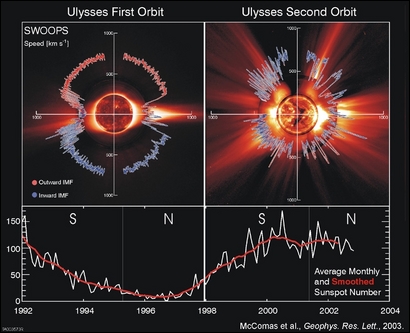For more than 17 years the Ulysses spacecraft studied the sun, pioneering solar science and defining our knowledge of the sun’s heliosphere. But on July 1, the mission will end. The spacecraft has been slowly “dying” due a dwindling power supply which can no longer keep the spacecraft warm enough. But Ulysses lasted almost four times its expected lifespan and has forever changed the way scientists view the sun and its effect on the surrounding space.
Ulysses ends its career after revealing that the magnetic field emanating from the sun’s poles is much weaker than previously observed. This could mean the upcoming solar maximum period will be less intense than in recent history.
“Over almost two decades of science observations by Ulysses, we have learned a lot more than we expected about our star and the way it interacts with the space surrounding it,” said Richard Marsden, Ulysses project scientist and mission manager for the European Space Agency (ESA). “Solar missions have appeared in recent years, but Ulysses is still unique today. Its special point of view over the sun’s poles never has been covered by any other mission.”
Ulysses is in a six-year orbit around the Sun. Its long orbital path carries it out to Jupiter’s orbit and back again. The further it ventures from the Sun, the colder the spacecraft becomes. Once it drops to 2ºC, the spacecraft’s hydrazine fuel will freeze.
This has not been a problem in the past because Ulysses carries heaters to maintain a workable on-board temperature. The spacecraft is powered by the decay of a radioactive isotope and over the 17-plus years, the power it has been supplying has been steadily dropping. Now, the spacecraft no longer has enough power to run all of its communications, heating and scientific equipment simultaneously.
The spacecraft and its suite of 10 instruments had to be highly sensitive, yet robust enough to withstand some of the most extreme conditions in the solar system, including intense radiation while passing by the giant planet Jupiter’s north pole.
Ulysses was the first mission to survey the environment in space above and below the poles of the sun in the four dimensions of space and time. It showed the sun’s magnetic field is carried into the solar system in a more complicated manner than previously believed. Particles expelled by the sun from low latitudes can climb to high latitudes and vice versa, sometimes unexpectedly finding their way out to the planets. Ulysses also studied dust flowing into our solar system from deep space, and showed it was 30 times more abundant than astronomers suspected. In addition, the spacecraft detected helium atoms from deep space and confirmed the universe does not contain enough matter to eventually halt its expansion.
Ulysses has traveled over 8.6 billion kilometers (5.4 billion miles) during its lifetime.
“Ulysses has been a challenging mission since launch,” said Ed Massey, Ulysses project manager at JPL. “Its success required the cooperation and intellect of engineers and scientists from around the world.”
Ulysses has been a joint mission between NASA and ESA.
“When the last bits of data finally arrive, it surely will be tough to say goodbye,” said Nigel Angold, ESA’s Ulysses mission operations manager. “But any sadness I might feel will pale in comparison to the pride of working on such a magnificent mission. Although operations will be ending, scientific discoveries from Ulysses data will continue for years to come.”
News Source: JPL Press Release



maybe this is a dumb observation….
But if it’s studying the sun…. when why wouldn’t it have solar panels vs. batteries….
Well Im one to sad to see it go 🙁 but its given us so much more than expected, truly a marvel.
Maybe because the sun is quite far away from the orbit of Jupiter?!
One of our most successful electronic children, Ulysses has far and away outperformed its expected life of service. Now it can rest, out there between the bodies of the Solar System, under the light of countless stars. Ave atque vale, Ulysses — may there be some sort of electronics heaven where you and all our other faithful landers and probes go after a lifetime of such wonderful service.
So sad, at least the legendary Ulysses got to come home after 20 years…
I see the makings of an epic space opera…
Ulysses dying is an opportunity for SETI to test it’s ability to capture diminishing RFdata signals. The ability to detect femto-watt levels of modulated RF is key to alien discovery.
We will miss you Ulysses… See you there…
E nd of an era.
Goodbye, Old Friend.
Your work will live on…………